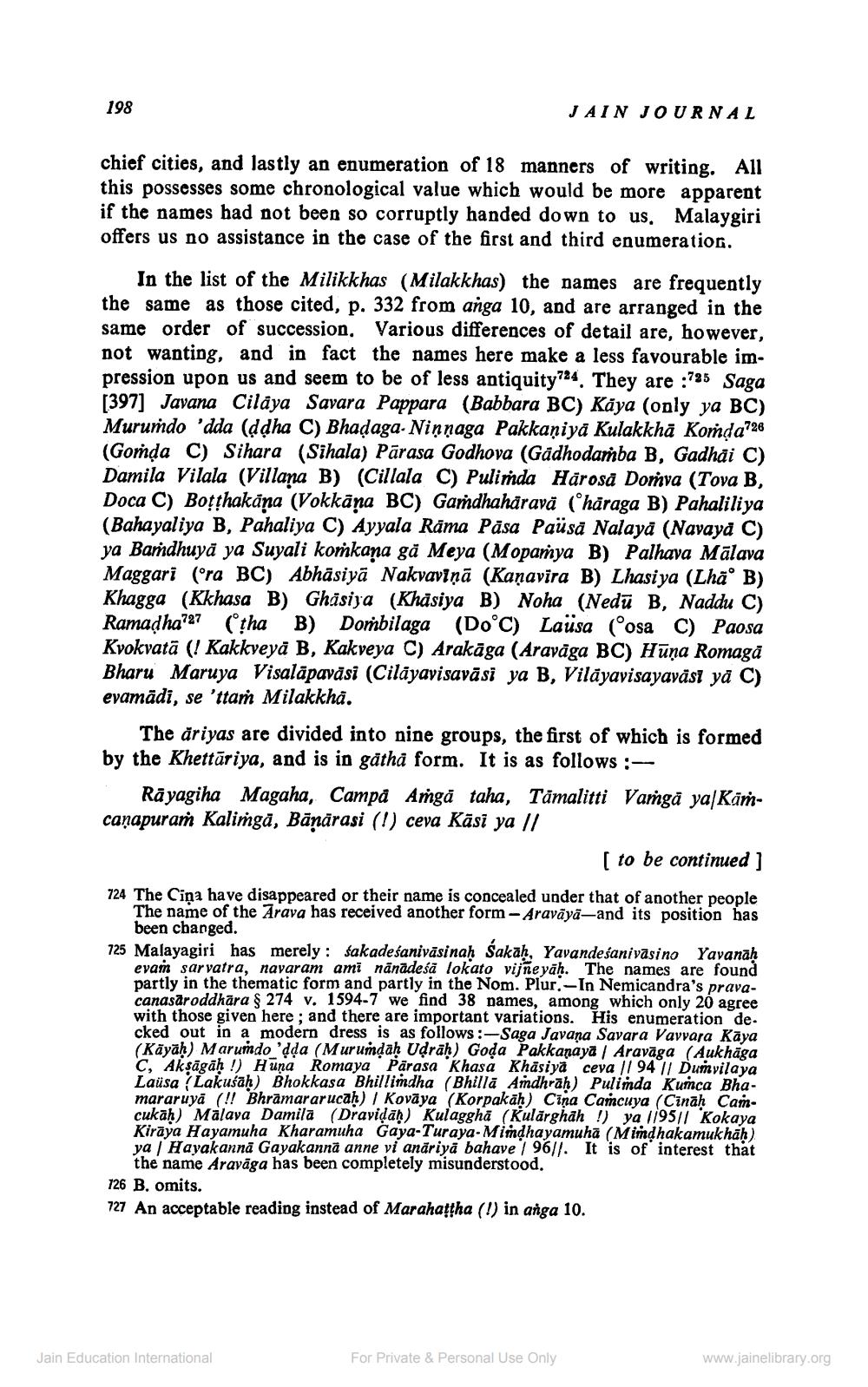________________
198
JAIN JOURNAL
chief cities, and lastly an enumeration of 18 manners of writing. All this possesses some chronological value which would be more apparent if the names had not been so corruptly handed down to us. Malaygiri offers us no assistance in the case of the first and third enumeration.
In the list of the Milikkhas (Milakkhas) the names are frequently the same as those cited, p. 332 from anga 10, and are arranged in the same order of succession. Various differences of detail are, however, not wanting, and in fact the names here make a less favourable impression upon us and seem to be of less antiquity724. They are :725 Saga [397] Javana Cilaya Savara Pappara (Babbara BC) Kaya (only ya BC) Muruído 'dda (ddha C) Bhadaga. Niņņaga Pakkaņiya Kulakkhā Komda?26 (Gorda C) Sihara (Sihala) Pārasa Godhova (Gadhodamba B, Gadhãi C) Damila Vilala (Villana B) (Cillala C) Pulinda Härosa Dorva (Tova B, Doca C) Bothakāna (Vokkāna BC) Gamdhaharavă (häraga B) Pahaliliya (Bahayaliya B, Pahaliya C) Ayyala Rama Pasa Paüsă Nalaya (Navaya C) ya Bardhuyā ya Suyali korkana gå Meya (Moparya B) Palhava Mālava Maggari (ora BC) Abhāsiyā Nakvaviņā (Kaņavira B) Lhasiya (Lhão B) Khagga (Kkhasa B) Ghäsiya (Khasiya B) Noha (Nedu B, Naddu C) Ramadha727 (tha B) Dombilaga (Do°C) Lausa (osa C) Paosa Kvokvatā (! Kakkveya B, Kakveya C) Arakāga (Aravāga BC) Hūņa Romagā Bharu Maruya Visalāpavāsi (Cilāyavisavāsi ya B, Vilāyavisayavasi ya C) evamädi, se 'ttaṁ Milakkha.
The åriyas are divided into nine groups, the first of which is formed by the Khettāriya, and is in gåtha form. It is as follows:
Rāyagiha Magaha, Campå Asgå taha, Tämalitti Varga ya/Kāṁcanapuram Kalimgā, Bānārasi (!) ceva Kāsi ya //
[ to be continued ]
724 The Cina have disappeared or their name is concealed under that of another people
The name of the Arava has received another form - Aravāyā-and its position has
been changed. 725 Malayagiri has merely: sakadeśanivāsinah Sakah, Yavandeśanivasino Yavanah
evan sarvatra, navaram ami nānādeśā lokato vijneyāḥ. The names are found partly in the thematic form and partly in the Nom. Plur.-In Nemicandra's pravacanasāroddhāra $ 274 v. 1594-7 we find 38 pames, among which only 20 agree with those given here ; and there are important variations. His enumeration de. cked out in a modern dress is as follows:-Saga Javana Savara Vavvara Kaya (Kāyāh) Marundo 'dda (Murundah Udrāh) Goda Pakkanaya | Aravāga (Aukhāga C, Aksāgah !) Huna Romaya Parasa Khasa Khāsiya ceva // 94 // Dunvilaya Lausa Lakušah) Bhokkasa Bhillindha (Bhillā Andhrah) Pulimda Kumca Bhamararuya (!! Bhramararucah) I Kovāya (Korpakāh) Cina Camcuya (Cināh Cancukāh) Malaya Damila (Dravidāh) Kulagghā (Kulārghāh!) ya 119511 Kokaya Kirāya Hayamuha Kharamuha Gaya-Turaya-Miidhayamuha (Mindhakamukhah) ya / Havakannā Gayakannä anne vi anāriya bahave / 96/1. It is of interest that
the name Araväga has been completely misunderstood. 126 B. omits. 727 An acceptable reading instead of Marahattha (1) in anga 10.
Jain Education International
For Private & Personal Use Only
www.jainelibrary.org




